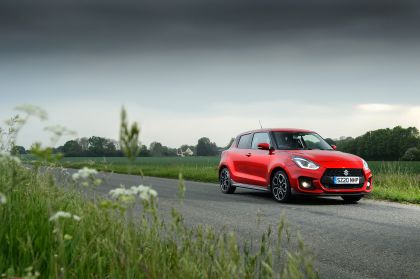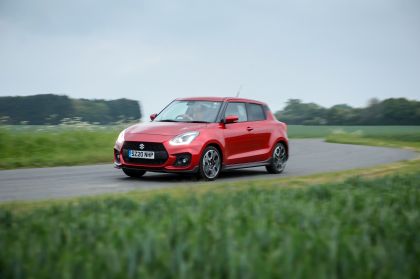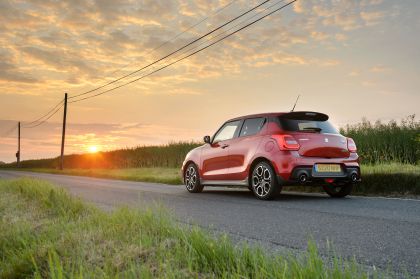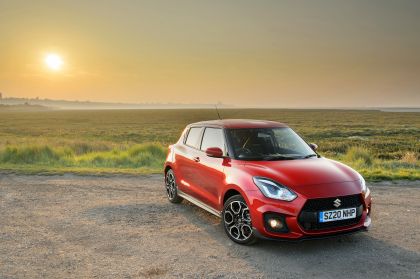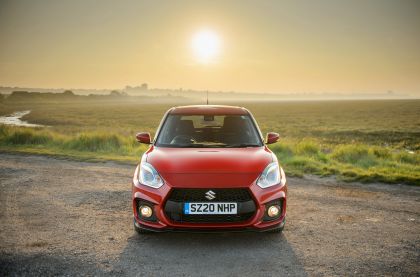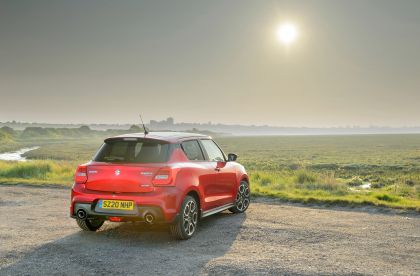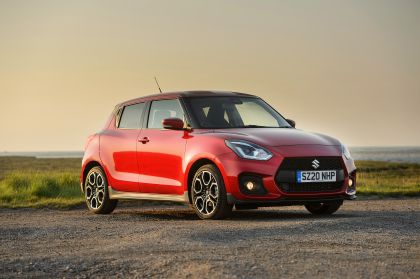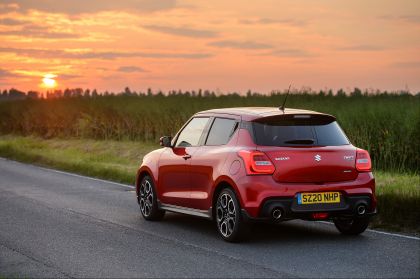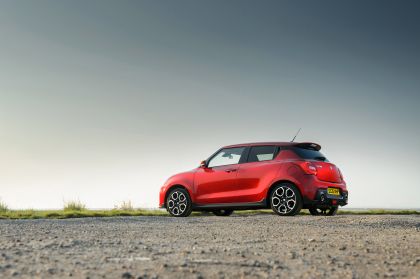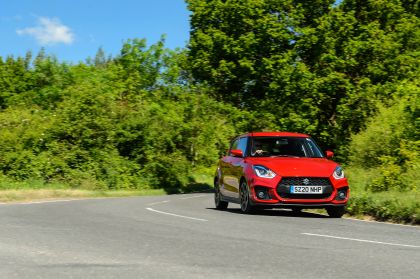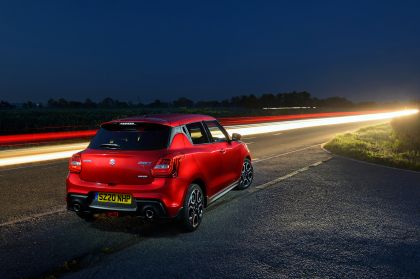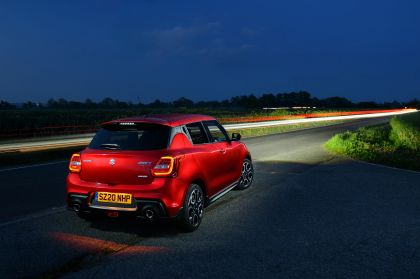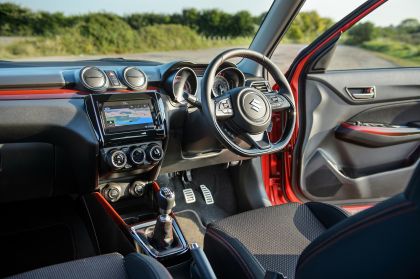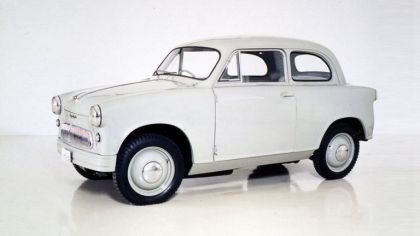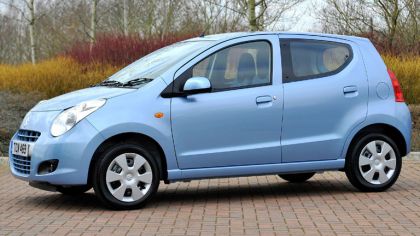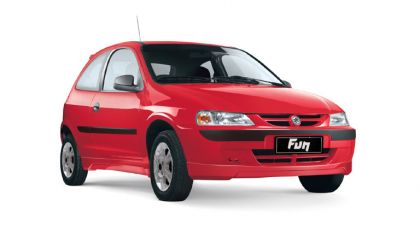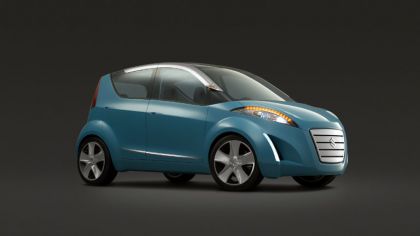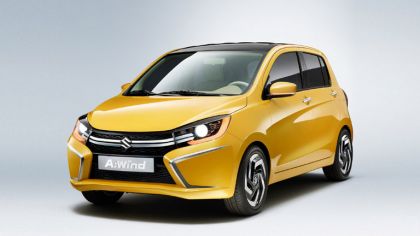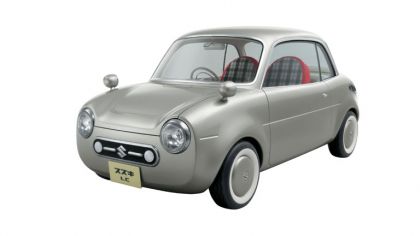Following on from its launch in the Japanese domestic market, Suzuki Motor Corporation unveiled the new Swift Sport for Europe at the 2017 Frankfurt Motor Show as its all new global compact sport supermini. The latest Suzuki Swift Sport represents an automotive advancement aimed at uplifting the driver through evolution and innovation. New Hybrid technology is incorporated into the 2020 model and it now has an even higher standard specification than before.
The Suzuki Swift Sport features an exclusive frontal design. The front grille and bumper project the nose beyond that of the standard Swift, conveying a sense of tautness and imminent action. Muscular shoulders, blacked-out A-pillars and vertically arranged front and rear lamps, as introduced in the rest of the Swift model range, are brought to life in the Swift Sport with black aerodynamic under spoilers spanning the front, sides and rear, and a roof-end spoiler that balances aerodynamic advantage with sports aesthetics.
At launch, Chief Engineer for the Swift Sport, Masao Kobori commented: "We know that our customers value a dynamic driving experience above everything else, so for the third-generation Swift Sport our development concept was "Ultimate driving excitement". It's lighter, sharper, quicker. It's more aggressive and emotive, but we've also refined the elements that make it practical to use every day especially the clutch feel, the manual transmission shift throw, the seats and steering wheel. Everything that puts the driver at the heart of the experience."
'HEARTECT' lightweight platform
Under the 'SUZUKI NEXT 100' plan announced at the Frankfurt Motor Show in 2015, Suzuki developed a new platform strategy for its future models and in 2018, the Swift Sport was introduced as the fourth model (following Baleno, IGNIS and Swift) to adopt this lightweight platform and be introduced in Europe.
Known as "HEARTECT" the lightweight platform delivers enhanced fundamental vehicle performance due to being light and highly rigid. A comprehensive overhaul of the underbody's structure and component layout resulted in the adoption of a highly rigid frame that enhances collision safety and has a continuous, smooth and curving form that better helps disperse energy. During development of the Sport model, an additional number of welds were added to the upper part of the rear door openings and the tailgate opening aperture which resulted in even stronger structural rigidity of the body.
Based on its very low kerb weight of 1,025kg and a torque figure of 235Nm, the latest Suzuki Swift Sport has a torque-to-weight ratio of 4.3 kg/Nm placing it at a similar level to its hot hatch competitors.
The Swift bodyshell (Body in White) is also of lightweight construction and includes the use of Ultra High tensile steel (980Mpa) across 17 per cent of its structure and High tensile steel (789 MPa) across four per cent of its structure.
The Swift Sport is 50mm longer than the standard Swift model and is 15mm lower than the previous model, further accentuating its low and wide stance.
Behind the Swift Sport: Aspects of Styling Innovation
Development of the Suzuki Swift Sport's exterior design was based on the concept of a "bold evolution of Swift's DNA". While resolute efforts were made so that the new model would inherit the model's characteristic styling, elements that needed refreshing were boldly transformed to innovatively evolve the new car.
The look of a low centre of gravity is further established by blacked-out pillars that create the appearance of a floating roof. Pillar-mounted rear door handles add both style and a sporty flair, while a high-tech look comes in the form of LED signature illumination used in the headlamps and rear-combination lamps.
For the interior, the highly dimensional instrument panel highlights a sense of nimble speed, while sporty and sophisticated red accent panels throughout the cockpit work with a basic tone of black to create a high contrast interior space. For added sport appeal, the tachometer features a red dial face and the speedometer is coloured silver.
A unique LCD display unit is used in the centre, with coolant temperature and fuel gauge incorporated within the two main gauges and exclusive alloy pedals are also used to highlight the sporting character.
The front seats are of semi-bucket design and have exclusive tubular frames set within the side supports of both the seatback and seat base cushion with fine tuned urethane pads for additional support during cornering at high speed. The seat fabric is of unique design and features embossed 'Sport' logos.
The steering wheel is also exclusive to the Sport with a dimpled leather design for secure grip and matt and satin black inlays together with a red stitching design which also features on the gear lever gaiter boot.
Reduced Wind Resistance
A roof spoiler helps keep maximum tyre contact with the road by decreasing lift at high speeds; aerodynamics have been improved further with a new design engine undercover, floor undercovers and front intake strakes. Wind resistance is reduced by 10 per cent overall compared to the previous Sport model.
Capacity
Adopting Suzuki's latest generation platform strategy minimised the size of the engine compartment which has enabled maximising the space available for cabin occupants and luggage. Within its compact body size, Swift features a roomy and comfortable cabin with ample space between occupants, ample headroom and legroom contributing to its relaxing environment. The luggage capacity with rear seats raised is 265L which is 25 per cent larger than the previous Swift Sport model.
48V Hybrid Technology
Similar in basic principle to the 12V Hybrid system that Suzuki pioneered in 2016 and which is now fitted to all manual transmission Ignis models and all Swift models from the Summer of 2020, the newly developed 1.4 Boosterjet with 48V Hybrid Powertrain for Suzuki Swift Sport helps to reduce fuel costs and lower CO2 emissions, but is very lightweight in design to preserve Suzuki Swift Sport's fun to drive performance characteristics. The hybrid system's main components weigh just 15kg.
The new and higher-powered Suzuki system consists of a 48V lithium-ion battery, Integrated Starter Generator (known as ISG) and 48V-12V (DC/DC) converter to power components requiring lower voltage including lights, audio and air conditioning. The ISG acts as both a generator and starter motor, is belt driven and assists the petrol engine during vehicle take off for a higher level of torque with 235Nm available from less than 2,000rpm and up to 3,500rpm.
The compact and high-performance lithium-ion battery stores electrical energy recovered from deceleration and braking and incorporates an idle stop function operated via the Integrated Starter Generator. This battery, as well as the DC/DC convertor unit, are located under the front seats to assist overall weight distribution.
The 48V Hybrid system also has new additional features which are Torque-fill control to raise engine response and Torque boost to make acceleration even smoother. These features enhance driving feel by adding torque from the electric motor to engine torque during acceleration.
Based on engine speed and throttle position, the engine ECU judges when the driver will accelerate and then uses electric motor assist to add additional torque.
In summary, a typical condition where Torque-fill control is utilised is when the driver presses the accelerator quickly and the electric motor is able to supply additional torque to the petrol engine without delay.
Even though the Boosterjet turbo charger of the K14D engine becomes fully operational from just 2,000rpm, Torque Boost is beneficial at even lower engine speeds as it helps optimise the torque curve and provide even smoother acceleration when full throttle is applied from rest.
A further efficiency benefit of the new 48V Hybrid system is the introduction of electric motor idling when the clutch is disengaged and vehicle speed is below approximately 50mph (80km/h). This feature essentially replaces fuel injection with power from the electric motor to then control and maintain engine idling while the vehicle is decelerating below 10mph and when stationary.
This function therefore eliminates fuel consumption under these conditions as engine momentum is electrically controlled by the ISG unit and the car is ready to re-accelerate on request with no engine restart delay.
Raising the ISG's power supply from 12V (as per Ignis and Swift 1.2-litre) to 48V increases electric motor output to 10.0Kw which in turn increases the amount of electric motor assist and regenerated energy.
The table below illustrates the amount of CO2 saved and the improvements in WLTP fuel consumption of the K14D Hybrid models versus previous models with K14C engine
Engine technology
After the initial introduction of the 1.4-litre Boosterjet turbocharged engine in Vitara and S-Cross during 2016, this engine technology was extended to the Swift Sport in June 2018.
The 1.4-litre engine has now been developed further for the 2020 model. It is designated as K14D and incorporates a new electric Variable Valve Timing (VVT) system for the intake side as well as new design fuel injectors and a higher pressure fuel pump. The exhaust camshaft side is controlled via a conventional Hydraulic VVT actuator.
The Dual VVT system improves engine performance by continuously varying both intake and exhaust valve timing to suit engine operating conditions and the electric motor drive intake VVT has a characteristic to shift the timing phase more smoothly regardless of engine oil temperature and engine speed. The combined effect of the two VVT's attains optimum engine power, improved fuel efficiency and low CO2 emissions.
Offering the same level of power and torque of a much larger capacity normally aspirated engine (2.0-litre), it delivers an effortless drive and genuine driving pleasure.
Boosterjet technology is Suzuki's own development and is characterised by improved fuel efficiency and driving pleasure made possible by using a small displacement, high torque turbocharger. By controlling the wastegate valve, which closes to create higher boost pressure during heavy load operation and remains open during normal driving, the Boosterjet system reduces pumping loss, thus achieving high levels of both power and fuel-efficiency. An air bypass valve is also utilised to prevent turbo 'stall' after the throttle has been closed and then quickly reopened.
Fuel is now injected at a higher pressure of 360 Bar into the combustion chamber during the air intake stroke which then forms a rich mixture around the spark plug and leaner mixture around the outer edge of the piston. The tumble flow of the fuel is created by utilising a straight intake port and a complex shape piston crown design.
A variable fuel control system is also utilised that optimally monitors fuel injection pressure according to the driving situation. By widening the range of fuel injection, PM (Particulate Matter) and PN (Particulate Number) emissions are reduced across the low to high engine speed ranges. This helps promote fuel atomisation and also improves fuel combustion efficiency.
The Boosterjet engine has been developed with Suzuki's ethos of reducing weight and size with added response and smooth power delivery to achieve the characteristics that Suzuki engines are renowned for.
During development, Suzuki's engineers virtually eliminated the typical delay in turbo power delivery or 'lag' by attaching the compact turbo charger directly to the cylinder head as well as incorporating the exhaust manifold into the cylinder head casting. This design ensures optimum gas flow with minimal heat loss through to the turbo unit. The turbocharger has a boost pressure of 1.0 Bar.
Historically, power and torque delivery from a turbo-charged engine would not have been available until much higher engine speeds, offering less flexibility to the driver. This is now enhanced even further with the adoption of the 48V Hybrid system.
Enhanced Cooling
During development and in order to manage the additional performance of the Swift Sport, a larger capacity radiator was utilised that improves heat dissipation by up to 34 per cent versus the previous generation model. The Sport also uses a later design twin electric fan assembly which achieves a 38 per cent increase in airflow whilst keeping overall quietness to the same level to that of a single electric fan.
Intake system
The engine uitilises a light and compact short port intake manifold with dual intake air pressure sensor control for higher response. An air cooled intercooler for the turbo charger offers greater volumetric efficiency along with new high capacity air cleaner for greater NVH performance.
Sports Exhaust system
The Suzuki Swift Sport features a specially tuned exhaust system with an optimised internal structure and is of larger capacity than standard to accommodate the higher engine output. The exhaust has been thouroughly tuned to produce low frequency notes in the lower speed ranges and retains its signature dual tailpipe design as used in the previous generation model.
Six speed transmission
The Sport model utilises a six speed manual transmission that is an evolution of the type used in the previous model. In development, numerous enhancements were made for optimum gear shift feel which included the fitment of a new gear lever with 10 per cent shorter throw. Other modifications include the use of a triple cone synchromesh for first and second gear and a double cone synchromesh for third gear.
Suspension
Fitting with its position as Suzuki's flagship sports model, the advanced handling capabilities found in previous Swift Sport models were further refined in the development and launch of the 2018 model offering greater driving stability, optimised roll rigidity, and improved dynamic response. Suspension roll angle has been significantly reduced compared with the previous model and is now on par with its closest competitors.
Carrying on from its earlier predecessors, the latest Swift Sport uses Monroe® front shock absorbers, which have a reputation for high performance. In development of the latest model and to improve roll stability, the thickness of the stabiliser joint bars was increased. The wheel hub and wheel bearings are incorporated into a single unit, and the width between the bearings was expanded which resulted in a 15 per cent increase in camber rigidity during cornering. These enhancements provide an added degree of stiffness without excessively increasing the spring rate of the springs or the front stabiliser and help maintain a supple movement in road-tyre contact.
The rear suspension was specially designed to ensure superior stability even at high speeds. The trailing arm was developed exclusively for the Suzuki Swift Sport to minimise deformation during cornering. The new model's toe rigidity has been improved by 1.4 times compared to the earlier model and camber rigidity is higher by a factor of nearly three. The torsional rigidity of the torsion beam is also tuned to provide optimal roll stiffness.
Braking System
An enhanced braking system is used to that of the standard Swift model in order to match the additional performance available. The front ventilated brake discs are 285mm in diameter with a width of 24mm and a calliper diameter of 123.5mm. Increasing the thickness and diameter of the discs has further improved braking efficiency from high speeds and also reduced disc temperature increase after repeated braking by 10 per cent.
The rear discs are of solid design and incorporate a different brake pad material with higher fade resistance for improved braking performance at high temperatures.
Alloy Wheels
The 17-inch polished alloy wheels are of unique design to the Sport model and are very light in their composition. During manufacture and after the wheel has been cast, the rim is compressed and stretched using high pressure rollers in a process known as 'flow forming'.
Specification Highlights
Standard equipment is comprehensive and includes six airbags, air conditioning, leather steering wheel, privacy glass, DAB radio with Bluetooth and four speakers, LED daytime running lights, 17-inch wheels, body coloured door mirrors and four electric windows. The 2020 model Swift Sport is available in one solid colour and five metallic colours at no optional cost along with two further colours available optionally as two-tone with a black roof.
Standard specification is enhanced even further for the 2020 model Sport and now includes rear cross traffic alert, traffic sign recognition and blind spot monitor. Swift is equipped with rear view camera, Smartphone link display audio, front fog lamps, auto air conditioning, satellite navigation, Advanced forward detection system, Lane Departure Correction, keyless entry and start, rear electric windows, LED Headlamps, LED Combination rear lamps, adaptive cruise control and six speakers. A full equipment table is listed at the end of this press pack.
Advanced Safety equipment
The Swift adopts Suzuki's Total Effective Control Technology (TECT) concept that provides a high level of collision safety. Some of the features include collapsible structures that absorb impact energy in the event of a collision, a frame structure that effectively disperses impact energy, and rigid cabin structure.
Other safety features include ESP® (Electronic Stability Program), which helps ensure stability while driving, along with front, side and curtain airbags to protect occupants in the event of a collision from the front or side.
Advanced Forward Detection System
The Swift Sport features an advanced forward detection system that combines a monocular camera and a laser sensor for advanced safety functions, including autonomous emergency braking, lane departure warning and high beam assist. It also uses millimetre-wave radar to enable adaptive cruise control.
The advanced forward detection system monocular camera excels at mid to long distance detection and also recognition of traffic elements including pedestrians and lane markers. The laser sensor excels at monitoring shorter distance hazards and also night vision detection.
Dual Sensor Brake Support (DSBS)
The advanced forward detection system supports numerous safety technologies, chief among which is collision-mitigating Dual Sensor Brake Support (DSBS). With DSBS, at vehicle speeds from approximately 3mph to 62mph, if the system determines a risk of collision with a forward obstacle, it issues both an audio and visual warning. If there is a high risk of collision with a forward obstacle and the driver panic brakes, the system deploys brake assist, increasing braking force. If the risk of a collision increases even more, the system applies full automatic braking in an effort to avoid the collision or reduce damage.
High beam assist
At speeds of 25mph or higher, high beam assist is designed to automatically switch the headlights between "High" and "Low", depending on the presence of other vehicles and also the lighting environment.
Adaptive cruise control
When there is a vehicle in front, the adaptive cruise control system uses millimetre-wave radar to gauge the distance to it and automatically maintains vehicle-to-vehicle distance in line with the setting selected out of three possible settings. When there is no vehicle in front, the system maintains the speed from 25mph to 100mph (where permitted) as input by the driver.
Lane departure warning / Lane departure prevention function
When the vehicle is travelling at vehicle speeds of approximately 37mph and up to 100mph (where permitted) and is departing the lane without the driver using a turn signal, the system vibrates the steering wheel and lights a warning indicator in the instrument cluster to draw attention to lane departures caused by factors such as inattention to the road. As an additional feature on the Sport model the driver will also notice an automatic input from the steering wheel at this time to ensure the car remains in its correct direction of travel.
Blind Spot Monitor
Lane changing at speeds above 10mph is now made safer with the addition of the Blind Spot Monitor function. The system has two rear mounted side radar sensors that are capable of detecting vehicles located in or approaching the rear blind spots on either side of the vehicle. Once detected, a warning LED icon is illuminated in the relevant exterior mirror. If the driver ignores it and indicates to change lanes, a flashing LED icon is accompanied by a warning sound alert.
Vehicle Sway Warning
When the vehicle is travelling at vehicle speeds of approximately 37mph or above and is weaving from side to side within a lane, the system sounds a warning buzzer and lights an indicator on the instrument panel. This quickly draws the driver's attention to weaving caused by drowsiness or other factors.
Rear Cross Traffic Alert
At speeds of up to 5mph whilst in reverse, two rear mounted radar sensors are utilised to alert the driver of approaching vehicles on either side when reversing out of car parking spaces. If a vehicle is detected, the driver is given both a visual alert and a warning sound alert. This enables the driver to manouevre more safely out of parking spaces where vision may be obscured.
Traffic Sign Recognition
For the latest Swift Sport, traffic sign recognition monitors the road ahead for traffic signs. When it detects road signs such as speed limits or no passing zones, it displays the sign on the instrument display to help the driver remember which road signs the car has passed. For additional traffic signs showing supplementary information, a blank box is displayed under the main traffic sign to inform the driver.
Guide Me Lights
For convenience and safety after parking the car at night or when returning to it, Suzuki Swift Sport is fitted as standard with a 'guide me light' function that enables the dipped beam headlamps to remain on for 10 seconds after the door is locked / unlocked. This facility can also be adjusted to up to 25 seconds duration via the settings mode of the instrument cluster.
Advanced Multi-information display
The Swift Sport utilises a unique 4.2 inch high-definition colour LCD display that shows a range of information including turbo boost, engine oil temperature, engine output and torque data, fuel consumption, average speed, acceleration and brake operation as well as driving G-force tracking.
Display audio system with navigation and smartphone connectivity
The audio system has a Smartphone Linkage Display Audio (SLDA) with a large seven inch touch panel display that enables intuitive operation. This includes a three dimensional navigation map that makes landmarks easy to distinguish, the system also allows the driver to use certain smartphone applications with MirrorLink, Android Auto and Apple CarPlay connection.
Apple CarPlay is the smarter and safer way to use iPhone in the Swift Sport. Apart from making calls it also facilitates receiving directions for optimised traffic conditions, listening to music, accessing email, text messages and more.
The Hybrid Suzuki Swift Sport goes on sale in the UK in April 2020.
Key dimensions
- Length: 3,890mm
- Width: 1,735mm
- Height: 1,495mm
- Wheelbase: 2,450mm
- Track
- front: 1,510mm
- rear: 1,515mm
